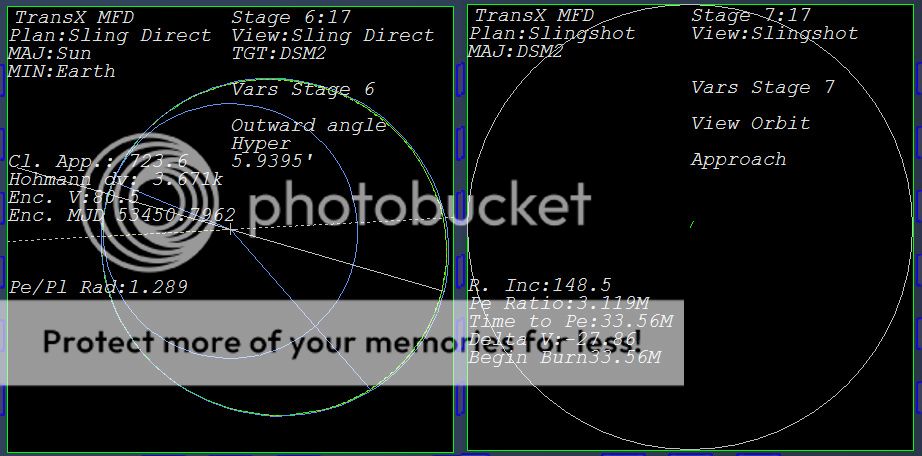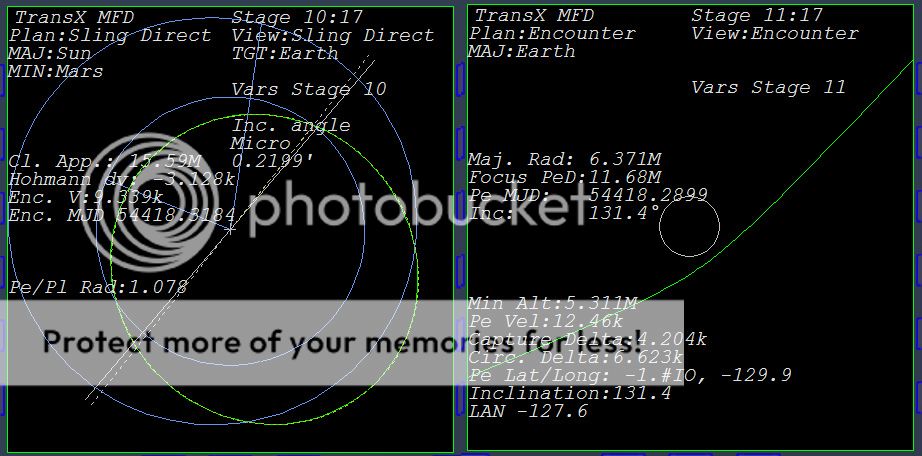[Part 1 here]
Before we begin the planning phase, we have to go to (Orbiterroot)\Scenarios\Rosetta\01-Rosetta launch.scn and change the date to 4 days earlier. The reason for this is because the DSM1 body we created will be inside Earth's SOI on the day of the launch.
Keep the waypoints note we made close, and run the scenario.
Open TransX and setup the following stages:
Stage1: MAJ Earth: Escape → FW
Stage2: MAJ Sun: Target DSM1 → FW
Stage3: MAJ DSM1: Escape → FW
Stage4: MAJ Sun: Target Earth → FW
Stage5: MAJ Earth: Escape → FW
Stage6: MAJ Sun: Target DSM2 → FW
Stage7: MAJ DSM2: Escape → FW
Stage8: MAJ Sun: Target Mars → FW
Stage9: MAJ Mars: Escape → FW
Stage10: MAJ Sun: Target Earth → FW
Stage11: MAJ Earth: Escape → FW
Stage12: MAJ Sun: Target Earth → FW
Stage13: MAJ Earth: Escape → FW
Stage14: MAJ Sun: Target DSM3 → FW
Stage15: MAJ DSM3: Escape → FW
Stage16: MAJ Sun: Target 67P → FW
Stage17: MAJ 67P: Target None → VW (Target base: No base)

This plan is a little peculiar. We need to start with the DSMs first, preferably in reverse order. The first one to set is the leg DSM3>67P (Stage16>17). We set the "Inherit Velocity" to "No", and the date as 55584. We adjust the other 3 parameters until we get a Cl.Approach to 67P (~100km) with the date of arrival matching the one on our notes (56818). We need to make sure that the Encounter Velocity is not higher than the Insertion dV.

Now let's do the DSM2>Mars leg (Stage8>9). Again, we set the "Inherit Velocity" to "No", set the date and adjust the parameters until we make sure that our arrival date, Inclination and altitude match the ones from our notes as best we can.

Next is the DSM1>Earth leg (Stage4>5). Same as before.

With the DSMs done, it's time to fill in the gaps. Our job is to create a trajectory that arrives at the DSMs as close to the date we have set for each maneuver as possible.
First the Earth>DSM1 leg (Stage2>3). Here we can also use IMFD as a time-saving tool. We'll use the Course>Target Intercept program and set the departure and arrival dates. Then we will try to match IMFD's trajectory in TransX as best we can.
We aim for a Cl. Approach of less than a km and the date as close to the date of the DSM as possible.

Now the Earth1>DSM2 leg (Stage6>7). Here we need to keep in mind that the maneuver takes place after one revolution around the Sun, so we need to set the "Orbits to Icept" to "1.0". -This is probably the hardest to get right in all of the plan. Aim for a Cl.Approach to the DSM2 of less than a km, without worrying too much about the date. We just make sure that the Encounter Vel is in the ~20 m/s region; This means that will need a correction of about that amount.

Now the Mars>Earth2 leg (Stage10>11). Once again, we try to match the arrival parameters from our notes.

Earth2>Earth3 leg (Stage12>13). Same as before, with the addition of "Orbits to Icept: 1.0". By this time we have reached Stage13, so we can expect large inaccuracies. We'll try to stick as close as we can to the plan.

And finally, the Earth3→DSM3 leg (Stage14>15). By now the inaccuracies have pilled up, we'll just aim for as close to the plan as possible.

And we are done for now. On the next part, we will advance the date to the launch, make a few tweaks to the plan and then fly the mission.
The scenario with the TransX plan so far is attached on this post.
(Next part will be released Sunday Nov 30).
Before we begin the planning phase, we have to go to (Orbiterroot)\Scenarios\Rosetta\01-Rosetta launch.scn and change the date to 4 days earlier. The reason for this is because the DSM1 body we created will be inside Earth's SOI on the day of the launch.
Keep the waypoints note we made close, and run the scenario.
Open TransX and setup the following stages:
Stage1: MAJ Earth: Escape → FW
Stage2: MAJ Sun: Target DSM1 → FW
Stage3: MAJ DSM1: Escape → FW
Stage4: MAJ Sun: Target Earth → FW
Stage5: MAJ Earth: Escape → FW
Stage6: MAJ Sun: Target DSM2 → FW
Stage7: MAJ DSM2: Escape → FW
Stage8: MAJ Sun: Target Mars → FW
Stage9: MAJ Mars: Escape → FW
Stage10: MAJ Sun: Target Earth → FW
Stage11: MAJ Earth: Escape → FW
Stage12: MAJ Sun: Target Earth → FW
Stage13: MAJ Earth: Escape → FW
Stage14: MAJ Sun: Target DSM3 → FW
Stage15: MAJ DSM3: Escape → FW
Stage16: MAJ Sun: Target 67P → FW
Stage17: MAJ 67P: Target None → VW (Target base: No base)

This plan is a little peculiar. We need to start with the DSMs first, preferably in reverse order. The first one to set is the leg DSM3>67P (Stage16>17). We set the "Inherit Velocity" to "No", and the date as 55584. We adjust the other 3 parameters until we get a Cl.Approach to 67P (~100km) with the date of arrival matching the one on our notes (56818). We need to make sure that the Encounter Velocity is not higher than the Insertion dV.

Now let's do the DSM2>Mars leg (Stage8>9). Again, we set the "Inherit Velocity" to "No", set the date and adjust the parameters until we make sure that our arrival date, Inclination and altitude match the ones from our notes as best we can.

Next is the DSM1>Earth leg (Stage4>5). Same as before.

With the DSMs done, it's time to fill in the gaps. Our job is to create a trajectory that arrives at the DSMs as close to the date we have set for each maneuver as possible.
First the Earth>DSM1 leg (Stage2>3). Here we can also use IMFD as a time-saving tool. We'll use the Course>Target Intercept program and set the departure and arrival dates. Then we will try to match IMFD's trajectory in TransX as best we can.
We aim for a Cl. Approach of less than a km and the date as close to the date of the DSM as possible.

Now the Earth1>DSM2 leg (Stage6>7). Here we need to keep in mind that the maneuver takes place after one revolution around the Sun, so we need to set the "Orbits to Icept" to "1.0". -This is probably the hardest to get right in all of the plan. Aim for a Cl.Approach to the DSM2 of less than a km, without worrying too much about the date. We just make sure that the Encounter Vel is in the ~20 m/s region; This means that will need a correction of about that amount.

Now the Mars>Earth2 leg (Stage10>11). Once again, we try to match the arrival parameters from our notes.

Earth2>Earth3 leg (Stage12>13). Same as before, with the addition of "Orbits to Icept: 1.0". By this time we have reached Stage13, so we can expect large inaccuracies. We'll try to stick as close as we can to the plan.

And finally, the Earth3→DSM3 leg (Stage14>15). By now the inaccuracies have pilled up, we'll just aim for as close to the plan as possible.

And we are done for now. On the next part, we will advance the date to the launch, make a few tweaks to the plan and then fly the mission.
The scenario with the TransX plan so far is attached on this post.
(Next part will be released Sunday Nov 30).
